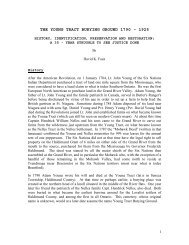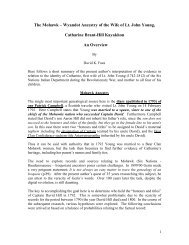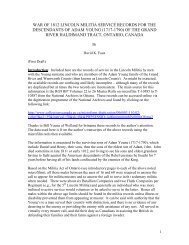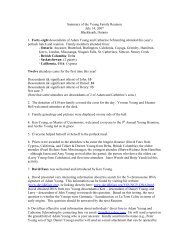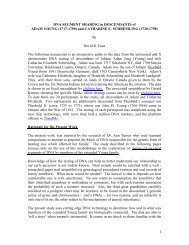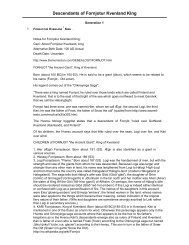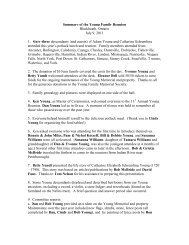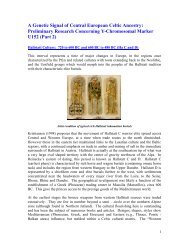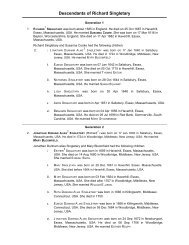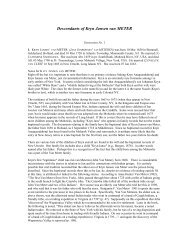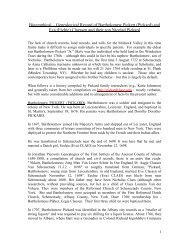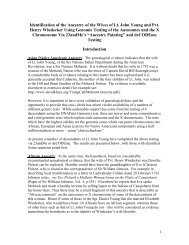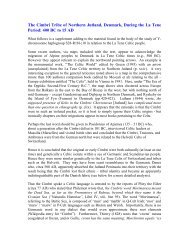Descendants of Hughes I de Cavalcamp Seigneur ... - Davidkfaux.org
Descendants of Hughes I de Cavalcamp Seigneur ... - Davidkfaux.org
Descendants of Hughes I de Cavalcamp Seigneur ... - Davidkfaux.org
You also want an ePaper? Increase the reach of your titles
YUMPU automatically turns print PDFs into web optimized ePapers that Google loves.
Generation 4 (con't)<br />
The el<strong>de</strong>r <strong>of</strong> Robert <strong>de</strong> Tosny's younger daughters was A<strong>de</strong>lisa, wife <strong>of</strong> Roger Bigod at his <strong>de</strong>ath<br />
in 1107. It is probable that Roger was married only once, although he is usually credited with two<br />
wives <strong>of</strong> the same name on the inconclusive evi<strong>de</strong>nce <strong>of</strong> a pro anama clause in a charter <strong>of</strong> his<br />
son William. Roger and his wife A<strong>de</strong>lisa gave charter for Rochester priory which referred to their<br />
sons and daughters and was attested by their children William, Humphrey, Gunnor and Matilda.<br />
This charter tellingly refers to King Henry, making it highly unlikely that Roger acquired a second<br />
wife and second family before his <strong>de</strong>ath in 1107. It is likely that Rogers' children were born from<br />
the late 1090s onwards, and that the youngest <strong>of</strong> them were Hugh and Cecilia. Roger's daughters<br />
Gunnor and Matilda were married soon after 1107. Gunnor's marriage to Robert fitz Swein <strong>of</strong><br />
Essex had perhaps been arranged by her father. Matilda was married to William <strong>de</strong> Albini<br />
pincerna by Henry I who bestowed 10 Bigod fees on her as a marriage portion. The marriages<br />
certainly took place before A<strong>de</strong>lisa <strong>de</strong> Tosny became the heiress to Belvoir on the <strong>de</strong>ath without<br />
issue <strong>of</strong> her el<strong>de</strong>st sister Albreda, some time between 1115/18 and 1129, when A<strong>de</strong>lisa, as<br />
widow <strong>of</strong> Roger Bigod, accounted for her father's land <strong>of</strong> Belvoir.<br />
In 1129 the sole surviving issue <strong>of</strong> Robert <strong>de</strong> Tosny were his younger daughters A<strong>de</strong>lisa Bigod and<br />
Agnes <strong>de</strong> Beaufour, who was then already married to Hubert <strong>de</strong> Ryes. At that date his Bigod<br />
granddaughter Matilda <strong>de</strong> Albini was probably already <strong>de</strong>ad and her sister Gunnor not long removed<br />
from her second marriage to Haimo <strong>de</strong> St Clair. Of their siblings, only Hugh Bigod and Cecilia, then<br />
wife <strong>of</strong> William <strong>de</strong> Albini Brito, survived. The Carta returned by Hugh Bigod in 1166 shows him holding<br />
the fee <strong>of</strong> his aunt Albreda <strong>de</strong> Insula. At the same date William <strong>de</strong> Albini Brito II held the fee <strong>of</strong> Belvoir.<br />
The conclusion from this must be that A<strong>de</strong>lisa succee<strong>de</strong>d Albreda in the fees <strong>of</strong> both Berengar and<br />
Robert <strong>de</strong> Tosny as next surviving sister. When she in her turn died she left issue <strong>of</strong> both sexes. Her<br />
sole surviving son Hugh succee<strong>de</strong>d his aunt Albreda - and by extension, her el<strong>de</strong>st brother Berengar -<br />
as heir both to Berengar's tenancy-in-chief in Lincolnshire and the Norman lands <strong>of</strong> Robert <strong>de</strong> Tosny<br />
<strong>of</strong> Belvoir. His tenancy <strong>of</strong> Robert's Norman lands is shown in a Norman record <strong>of</strong> 1172 where he is<br />
named as holding land <strong>of</strong> the fee <strong>of</strong> Conches and Tosny. More important in terms <strong>of</strong> size in England,<br />
the lordship <strong>of</strong> Belvoir was nonetheless the lesser <strong>of</strong> the two Tosny lordships because it as not<br />
associated with their Norman heritage. As the inheritance <strong>of</strong> a woman married to an important tenantin-chief<br />
it could be expected to pass to one <strong>of</strong> her younger children and not her husband's principal<br />
male heir. Since she had no surviving younger sons after 1120, the <strong>de</strong>volution <strong>of</strong> Belvoir to one <strong>of</strong> her<br />
daughters was inevitable. Gunnor and Matilda had long since been provi<strong>de</strong>d for from their father's<br />
inheritance by the time, after c. 1115/1118, that A<strong>de</strong>lisa succee<strong>de</strong>d to Belvoir. Consequently it was the<br />
youngest daughter Cecilia - quite probably a mere infant at her father's <strong>de</strong>ath in 1107 - who became<br />
her mother's heiress. She was, <strong>of</strong> course , an heiress whose marriage could advantageously be used<br />
to reward one <strong>of</strong> the king's loyal new men. Cecilia's marriage to William <strong>de</strong> Albini Brito has been said<br />
to have occurred as early as 1107 on the basis <strong>of</strong> a Belvoir charter given by Ralph <strong>de</strong> Raines and<br />
attested by Roger Bigod, but it certainly took place much later. The Belvoir charter just mentioned<br />
probably begins to the early 1140s . It was attested by William <strong>de</strong> Albini senior and his wife Cecilia,<br />
their son William junior, Roger Bigod, Robert <strong>de</strong> Toteneio, Ralph <strong>de</strong> Albeneio and others. Since<br />
William, Robert and Ralph were certainly sons <strong>of</strong> William and Cecilia it is clear that Roger Bigod was<br />
also, as is confirmed by the or<strong>de</strong>r <strong>of</strong> their sons William, Robert, Roger, listed in the Thorney Liber vitae<br />
(BL Add, 40,000, fol. 2r) " http://users.ox.ac.uk/~prosop/prosopon/issue9-1.pdf<br />
In Stewart's monumental work (p.69) on the Robert <strong>de</strong> Tosny Lord <strong>of</strong> Belvoir family he states, "The<br />
fanciful i<strong>de</strong>a was put forward in the mid-19h century that ‘Spina’ and its variants came about from a<br />
play on the imagined origin <strong>of</strong> the name Tosny, see Senex in N&Q (1861) xi 276-277: ‘That this last<br />
place [Thosny or Toëny] was named after their Norwegian name, Thorn or Thorny, <strong>de</strong>scendants <strong>of</strong><br />
Thor, is evi<strong>de</strong>nt by the fact, that both the members <strong>of</strong> the Standard-bearer family, and also that <strong>of</strong><br />
Robert <strong>de</strong> To<strong>de</strong>ni, <strong>of</strong> Belvoir, are known as De Spineto and De Spina, in numberless charters and<br />
other documents’. In fact the number is apparently small, just three charter occurrences <strong>of</strong> Berenger<br />
Spina or Hespina 4.9 and this fourth case where an individual surnamed Spineta cannot be connected<br />
with any certainty to the Tosny family." The present author (DKF) is convinced that this name is a<br />
variant <strong>of</strong> todays Epinsay, close to the other manors." Stewart also <strong>de</strong>tails how Robert's <strong>de</strong>ath was in<br />
1093, not 1088 as is <strong>of</strong>ten assumed.http://wwwpersonal.umich.edu/~bobwolfe/gentxt/Origin_and_early_generations_<strong>of</strong>_the_<br />
Tosny_family.pdf (p.40).<br />
Robert was buried in the Priory, and this c<strong>of</strong>fin lid reads, ROBERT DE



